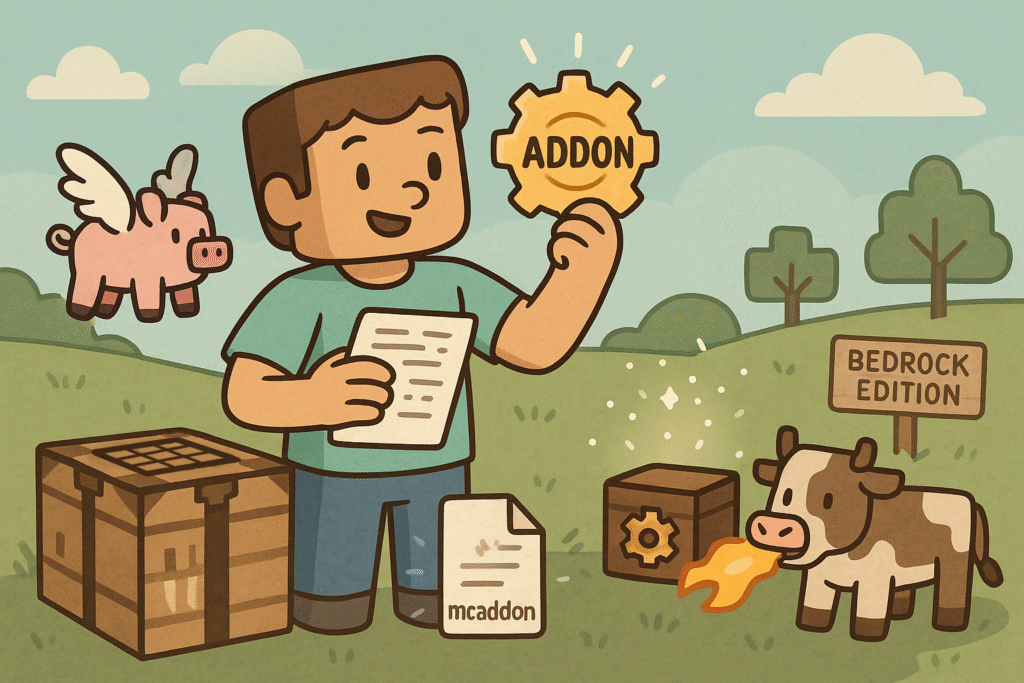You’ve probably seen it before. Players flying on dragons. Farming with machines. Turning chickens into explosive nightmare-fueled creeper-chickens.
Ok, I haven’t actually seen that last one, but I kind of want to make it now…
Well, good news for you. If you’ve ever wondered how they do that, or how can you do that too, the answer (at least on Minecraft Bedrock Edition) is with an addon.
Addons are Minecraft’s built-in way to customize the game without rewriting its code. They’re flexible, powerful (within the limits Mojang gives you), and give you incredible creative opportunities once you get the hang of them.
If you’re curious about modding, this is the best place to start.
Addons: Minecraft’s Built-In Modding System
At its core, an addon is just a bundle of files that changes how Minecraft behaves or looks.
It might add new items, change the way mobs act, or even introduce scripted events. What makes addons special is that they’re officially supported by the game. For addon consumers, that means no hacks, no launchers, and no third-party installers.
And trust me, that’s a good thing.
Wait—aren’t there mods on Java too?
Yes, but they’re not the same thing.
Addons are a Bedrock Edition feature… an official way to customize the game using structured files and scripts. On Java Edition, players use mods instead, which require third-party tools like Forge or Fabric, and they involve editing the game’s internal code.
That gives Java mods a lot more power. But with great power comes great complexity.
I’m not going to get into it here, but addons are safer, easier to share, and the capability is built right into the Bedrock engine.
Honestly, the difference between addons and mods is pretty pedantic, and throughout this site, I’m going to use the term modding interchangeably with creating addons.
What Can Addons Actually Do?
In a nutshell, addons can:
- Add new blocks, items, or entities
- Change mob behavior (e.g., a cow that attacks you instead of running away when you hit it)
- Alter crafting recipes or loot tables
- Add scripting logic to make things happen over time
- Replace textures, sounds, or models
Think of them like Lego instructions for the game. They don’t rebuild Minecraft from scratch. They just rearrange what’s already there and maybe add a few new bricks along the way.
What Addons Can’t Do (Yet)
Because addons work within Minecraft’s official framework, there are limits. For example, you can’t:
- Create new dimensions
- Fully customize the in-game UI
- Replace hard-coded game systems (e.g., nether portal creation)
- Modify vanilla block behavior
- Access the player’s computer file system
That said, Minecraft’s scripting system is growing rapidly. What’s impossible today might be standard tomorrow. The entire concept of the Industrial Revolution addon was impossible for me to implement two years ago.
How Are Addons Constructed?
Addons include either a Behavior Pack, a Resource Pack, or both.
The behavior pack controls how things work, like what a mob does or how an item functions. A resource pack controls how things appear, such as textures, models, sounds, and user interface elements.
Think of the behavior pack like a car’s engine, and a resource pack like the paint job.
These packs are zipped up and placed in specific folders that Minecraft reads when the game loads. You’ve actually already used addons without knowing it. The game has a base behavior and resource pack that it loads before any other addons. Any addons you use will build on top of those, and that gives them access to the textures and mobs and more that Minecraft already has.
Why Learn Addon Development?
Because it’s surprisingly achievable even if you’ve never written a line of code.
Addons are built on structured text files and logical thinking. If you can follow a recipe, you can probably write your first addon.
You’ll learn how different parts of the game fit together. You’ll troubleshoot, experiment, and iterate while building something you can actually play with. Personally, I get immense satisfaction from seeing something that I built appear in the game.
And, if you’re a parent or educator, it’s a clever way to sneak real-world skills into a fun, hands-on project.
In short, it’s a gateway to making Minecraft your own.
What to Expect from the Modding Section
If you’re new here, welcome. This section of the site is dedicated to helping you:
- Understand how addons work
- Use practical tools to speed up development
- Learn JSON and scripting step-by-step
- Start small and grow your skills over time
Whether you’re a parent, a teen with an idea, or just curious, you’ll find a friendly place to learn here.
Ready to go deeper? Keep on reading!

